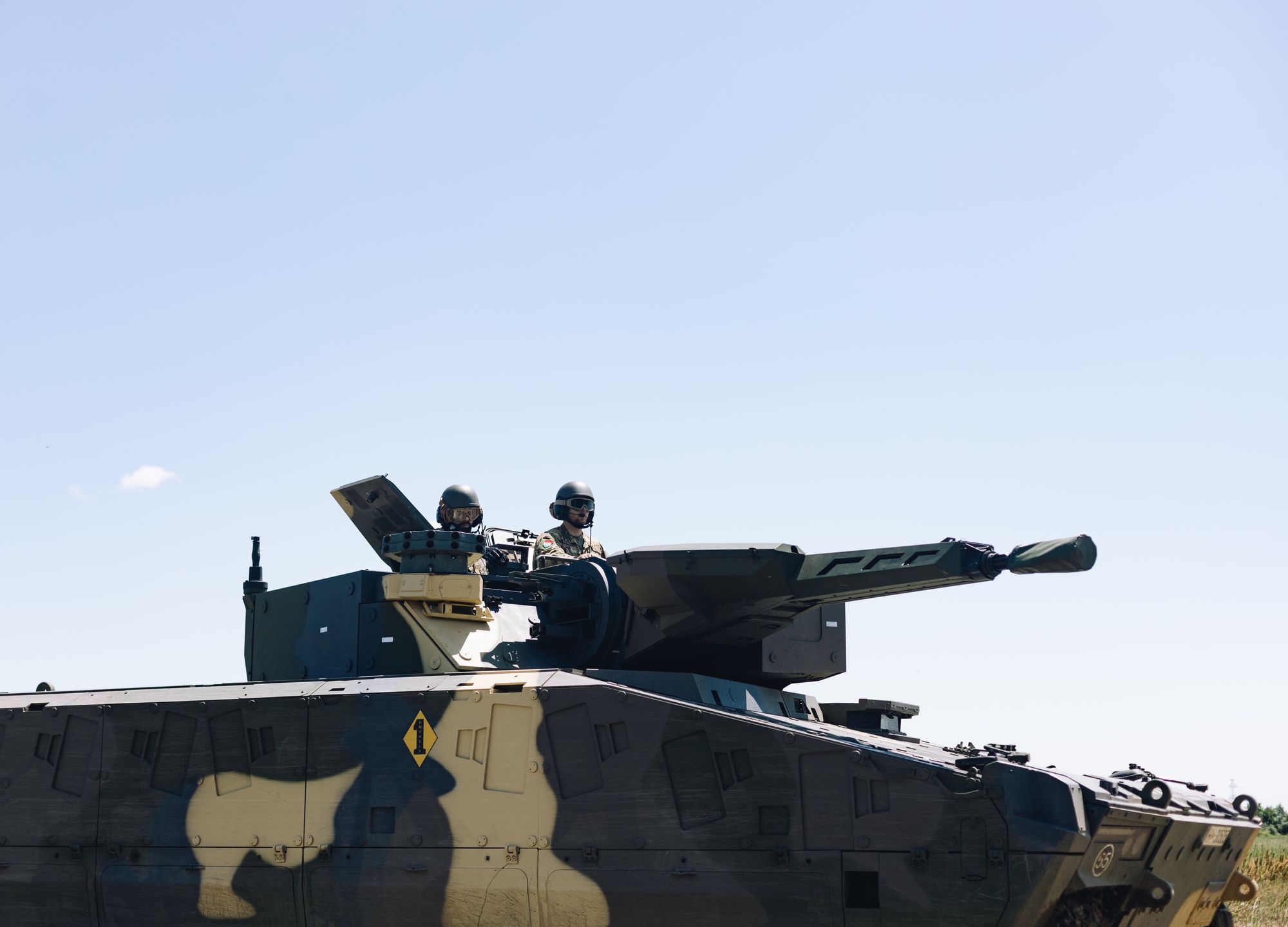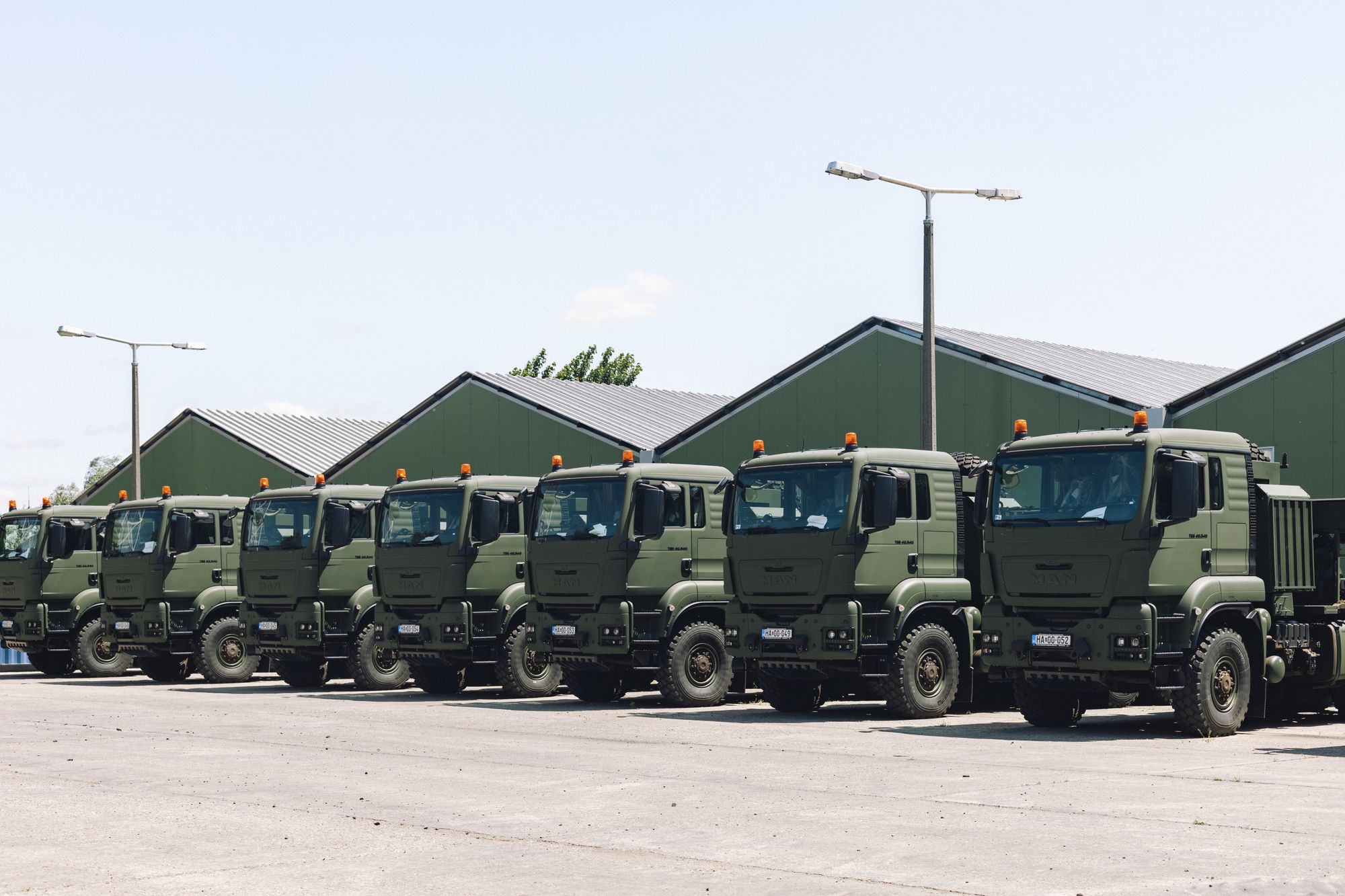With our radio helmets on, we are sitting in the cockpit of one of the world’s most advanced infantry fighting vehicles. The ramp closes, and the unique atmosphere created by the red light that breaks the darkness of the interior is broken by opening a hatch. Turning is quick with the crawler tracks, but we can feel the impacts of the variety of terrain in the cockpit. Our heads are bobbing around while the engine is humming smoothly as we head for the practice field at 60 km/h. It is an extraordinary but thought-provoking experience.How do riflemen feel while travelling for hours in an enclosed iron space to find themselves in the middle of the battle? Do they perhaps just hope that the interceptor drone would not hit their unit’s combat vehicle? The psychological pressure is staggering. Nevertheless, there is no doubt that the Lynx vehicles currently being tested, produced, and fielded in Hungary are the pinnacle of modern military technology.
This article originally appeared in issue no. 8 of the Hype&Hyper print magazine.


Rheinmetall takes Hungary
However, before we discuss the Lynx vehicles in detail, it is worth examining how the Düsseldorf-based international defence and automotive company Rheinmetall made its way to Hungary. The defence corporation’s name is associated with such advanced combat vehicles as the Leopard 2, the Boxer, the PzH2000, and, of course, the Lynx armoured fighting vehicle, the main topic of this article.
The Hungarian government launched the Defence and Forces Development Programme in 2016 with the aim of making the Hungarian Defence Forces one of the most modern regional armies by the end of 2030. The two decades after the fall of communism were not a golden age for armies: the defence forces of Hungary and other Central and Eastern European states were gradually downsized, and the defencebudgets were far below the 2% GDP NATO target. But a turning point came with the third Orbán government just when the Trump administration warned Europe that it was time to devote more effort to developing defence capacities. It is already history what has happened since then: on February 24 2022, the security environment in Europe fundamentally changed, and the NATO member states began to arm themselves and develop defencecapabilities quickly. Hungary is no exception.
Hungary is addressing a decades-long technical and infrastructural backlog with the announced Defence and Forces Development Programme. In 2020, an agreement was signed to purchase 218 Rheinmetall Lynx (KF41) combat vehicles. The Lynx was still on the drawing board and in the form of a few prototypes at that time, so the Hungarian Defence Forces were the first to field the world’s most advanced armoured fighting vehicles.

The Rheinmetall contract’s structure is advantageous from a Hungarian perspective: the first 46 Lynxes are built in Germany, while the rest will be produced in a new factory in Zalaegerszeg, Hungary, which will not only meet domestic demand but also future global needs. Rheinmetall Hungary Zrt. was established in 2020, the year when the contract was signed, with the German parent company as the majority shareholder (51%) and the Hungarian state as a minority shareholder (49%). The company will start the production of the Lynx combat vehicles in the summer of 2023, and approximately 50 Lynx will roll off the assembly lines in Zalaegerszeg every year.
Moreover, Rheinmetall’s decision means more than bringing the Lynx project to Hungary, as the ammunition production also gets boosted. A decision was made to establish a medium- and large-calibre ammunition production plant in Várpalota, Hungary, at the end of 2020, which will produce ammunition for the newly acquired Leopard 2, PzH2000, and Lynx vehicles, among other projects. The production is planned to start in 2024. The decision was taken before the war in Ukraine broke out, but the payback period for the project can, of course, significantly change due to the current security environment. In addition to the production lines, Rheinmetall will also install valuable research and development capacities in Hungary and expand its product range with the involvement of Hungarian specialists in the future. This step was confirmed in the spring of 2021 by Rheinmetall CEO Armin Papperger, who said that the company will develop and manufacture short-range air defence systems in Hungary. At this point, it is important to return for a moment to the Lynx factory in Zalaegerszeg, which is actually more than just a production plant: Rheinmetall says it will be „the most modern combat vehicle production and test facility in Europe,” with a test track and special chambers for testing electronic equipment in addition to the production hall.
Paul Walf, Rheinmetall’s Head of Corporate Coordination in Central Europe, told Mandiner about the cooperation between the German corporation and the Hungarian government: „The goals and long-term strategic visions of Hungary and Rheinmetall coincided almost completely, as the Hungarian side had the political priority of building a defence industrial base alongside the modernisation program of the Hungarian Defence Forces, while Rheinmetall did not simply want to attract new customers, but we were interested in expanding our capacities due to the rising number of orders.” The Executive Board of Rheinmetall recently listed Hungary as one of the four „home markets,” alongside Australia, the UK and Germany, which demonstrates the strong relationship and mutual trust between Budapest and them. This obviously implies an extension of certain interests. In November 2021, Rheinmetall acquired a 25.1 per cent stake in the Hungarian IT company 4iG through a share purchase and capital increase, making it the company’s largest international strategic investor. This was followed in 2022 by the establishment of a joint IT company, Rheinmetall 4iG Digital Services, which significantly strengthened Rheinmetall’s IT capacities, and meant that 4iG was able to enter the global market, providing IT services to Rheinmetall’s Hungarian and also other international subsidiaries.
Besides the Lynxes, the Hungarian state purchased 56 Leopard 2 tanks and 24 PzH2000 self-propelled howitzers as part of the army development program.

Testing, developing, and reaching the top
Let us return to the barracks yard in Hódmezővásárhely: Lynx is the latest generation armoured fighting vehicle, equipped with powerful active and passive protection systems, armament, and a range of sensor and reconnaissance systems to facilitate rapid situational awareness in combat. Its modular design is also noteworthy: Lynx can be easily customised for different tasks.
These are valuable qualities that the Hungarian Defense Forces vehicle fleet did not have before. The German high-tech combat vehicles will replace the old Soviet BTR armouredpersonnel carriers, bringing a complete generational change. And this generational change is necessary for combat methods, too, besides the combat vehicles, with Lynx offering new possibilities. „The Lynx vehicles will change our operations to a great extent, as they have very high armour protection that we can use well on the battlefield. Moreover, their manoeuvrability is excellent, and they move at high speed, not only forward but also in reverse,” Captain Árpád Fa, commander of the „Lynx squadron,” who has experienced many things from Afghanistan to Kosovo during his 11 years in the Hungarian Defence Forces, told our magazine. He stressed in the hangar that „the fact that this vehicle can go up to 35 km/h in reverse is a very important factor from a combat perspective because, if we ever have to leave the area quickly backwards, then with these vehicles, we can do it.” Furthermore, the vehicle will be equipped with a smoke grenade launcher, which can create a completely obscuring fog within a few seconds so that it cannot be seen even through thermal cameras. „With this cover feature, we can easily manoeuvre at high speeds, and this greatly increases the chances of survival on the battlefield,” said the captain.
However, if the clash cannot be avoided, the Lynx has one of the strongest armours in its class, and the ammunition stored in the turret is kept separate from the crew, so in the event of an ammunition explosion, the personnel will remain unharmed. A special feature is the combat vehicle’s active protection system, the Rheinmetall StrikeShield, which consists of 15 radar sensors, 35 electro-optical sensors, and 33 effectors, providing protection even against surface-to-surface anti-tank missiles. This all sounds nice, but how does such a system work in practice? „The core of the active protection system is that the vehicle is equipped with a system of sensors and countermeasure mechanisms. If the vehicle is targeted with an anti-tank missile, the system detects this and launches a counterattack detonating the missile a few meters away from the combat vehicle. So, it cannot hit the Lynx and pierce its armour, thus increasing the protection and survivability of the personnel,” the captain explained. Fa added that as long as the riflemen keep a distance of 8-10 meters from the combat vehicle, the active protection system’s shrapnel does not threaten them.
The main armament of the Lynx is a 30 mm autocannon, which according to the captain, is more like a „30 mm sniper rifle” as it can locate and destroy targets at a range of 3-4 kilometres with the highest accuracy. „We do not waste ammunition; we locate and destroy,” said the captain, who also shared a secret with us: There is armour-piercing ammunition, and there are cluster munitions that are programmable to explode at a given distance and can be helpful to destroy low-flying aircraft, soldiers behind cover, or the optical systems of a tank. This vehicle is designed to fight. The Soviet BTR is an armoured personnel carrier, meaning it is designed to stop before the battle, and the soldiers must leave for the fight. On the other hand, the Lynx is a combat vehicle made to fight, and the infantry should not necessarily need to get out,” said Árpád Fa. He also pointed out that the Lynx is more user-friendly than the BTR, it is comfortable, and it takes only a few minutes to explain to someone how to start, stop and change gear.

Captain Fa conducts tests on the Lynxes that have arrived with his team, and Rheinmetall is actively incorporating their experience and feedback into the fine-tuning of the vehicles. The captain told us that they are in almost weekly contact with Rheinmetall’s development engineers, sharing their practical experiences. This is essential as the Lynx is currently the world’s most advanced infantry fighting vehicle, testing is progressing steadily, and from the second half of the year, training of turret operators and sharpshooting will also begin. Fa’s team summarised the developments as follows: „We could not introduce new technical equipment of this significance in the rifle branch for decades, and with the Lynx project, we are not simply trying to catch up, but we are creating the capability to take the technological lead in the combat vehicle market. It is crucial that people can see what modern equipment we have and what positive changes are taking place in the Hungarian Defence Forces.”
Photos: Dániel Gaál
Continue reading H&H issue no.8!
ORDER HERE
"Thought and truth are infinite, they were before your material world." (x)

Yes, of Corsa!










